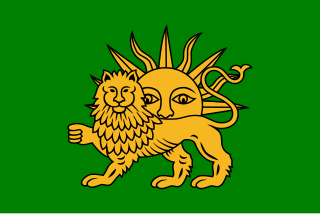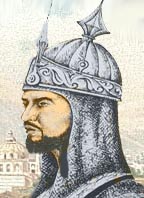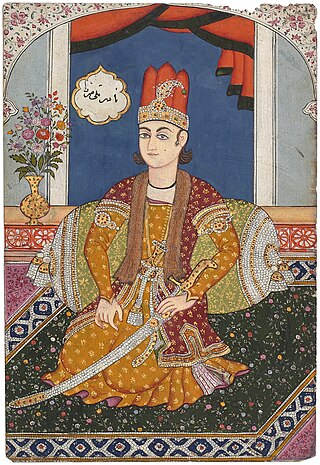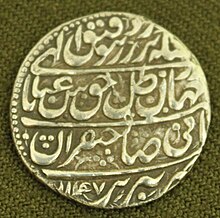
The Safavid dynasty was one of Iran's most significant ruling dynasties reigning from 1501 to 1736. Their rule is often considered the beginning of modern Iranian history, as well as one of the gunpowder empires. The Safavid Shāh Ismā'īl I established the Twelver denomination of Shīʿa Islam as the official religion of the Persian Empire, marking one of the most important turning points in the history of Islam. The Safavid dynasty had its origin in the Safavid order of Sufism, which was established in the city of Ardabil in the Iranian Azerbaijan region. It was an Iranian dynasty of Kurdish origin, but during their rule they intermarried with Turkoman, Georgian, Circassian, and Pontic Greek dignitaries, nevertheless, for practical purposes, they were Turkish-speaking and Turkified. From their base in Ardabil, the Safavids established control over parts of Greater Iran and reasserted the Iranian identity of the region, thus becoming the first native dynasty since the Sasanian Empire to establish a national state officially known as Iran.

Abbas I, commonly known as Abbas the Great, was the fifth Safavid shah of Iran from 1588 to 1629. The third son of Shah Mohammad Khodabanda, he is generally considered one of the most important rulers in Iranian history and the greatest ruler of the Safavid dynasty.

Soltan Hoseyn was the Safavid shah of Iran from 1694 to 1722. He was the son and successor of Shah Suleiman.

Shahrokh Mirza, better known by his dynastic title of Shahrokh Shah was the Afsharid king (shah) of the western part of Khorasan from 1748 to 1796, with a two-month interruption. A grandson of the Iranian conqueror Nader Shah, Shahrokh was the son of Reza Qoli Mirza Afshar and his Safavid wife Fatemeh Soltan Begom, who was the sister of Tahmasp II, the penultimate Safavid shah of Iran. Shahrokh's half-Safavid descent made him stand out amongst his Afsharid relatives, and was used to bolster the legitimacy of his grandfather. After the assassination of Nader Shah in 1747, his nephew Ali-qoli Khan, ascended the throne in Mashhad and had all of Nader Shah's descendants in fortress of Kalat massacred. Shahrokh was spared in case his Safavid lineage would come to use, and was instead kept in the fortress as a prisoner. While Adel Shah was battling his rebellious younger brother Ebrahim Mirza, a party of Turkic, Kurdish, and Arab tribal leaders took advantage of his absence and installed Shahrokh on the throne. Both Adel Shah and Ebrahim were eventually defeated and killed, but Shahrokh was not long afterwards overthrown by a party of dissident tribal leaders, who installed the Safavid pretender Mir Sayyed Mohammad on the throne. Shahrokh was soon blinded at the instigation of Mir Alam Khan Khuzayma and other leading nobles, much against Suleiman II's will.

Tahmasp II was the penultimate Safavid shah of Iran, ruling from 1722 to 1732.

Ali-qoli Khan, commonly known by his regnal title Adel Shah was the second shah of Afsharid Iran, ruling from 1747 to 1748. He was the nephew and successor of Nader Shah, the founder of the Afsharid dynasty.

Shāh Ashraf Hotak,, also known as Shāh Ashraf Ghiljī, son of Abdul Aziz Hotak, was the fourth ruler of the Hotak dynasty. An Afghan from the Ghilji Pashtuns, he served as a commander in the army of Mahmud Hotak during his revolt against the heavily declining Safavid Persians. Ashraf also participated in the Battle of Gulnabad. In 1725, he briefly succeeded to the throne to become Shah of Persia after he killed his cousin Mahmud.

Nader Shah Afshar was the founder of the Afsharid dynasty of Iran and one of the most powerful rulers in Iranian history, ruling as shah of Iran (Persia) from 1736 to 1747, when he was assassinated during a rebellion. He fought numerous campaigns throughout the Middle East, the Caucasus, Central Asia, and South Asia, such as the battles of Herat, Mihmandust, Murche-Khort, Kirkuk, Yeghevārd, Khyber Pass, Karnal, and Kars. Because of his military genius, some historians have described him as the Napoleon of Persia, the Sword of Persia, or the Second Alexander. Nader belonged to the Turkoman Afshars, one of the seven Qizilbash tribes that helped the Safavid dynasty establish their power in Iran.

The Ottoman–Persian War of 1730–1735 or Ottoman–Iranian War of 1730–1735 was a conflict between the forces of Safavid Iran and those of the Ottoman Empire from 1730 to 1735. After Ottoman support had failed to keep the Ghilzai Afghan invaders on the Persian throne, the Ottoman possessions in western Persia, which were granted to them by the Hotaki dynasty, came under risk of re-incorporation into the newly resurgent Persian Empire. The talented Safavid general, Nader, gave the Ottomans an ultimatum to withdraw, which the Ottomans chose to ignore. A series of campaigns followed, with each side gaining the upper hand in a succession of tumultuous events that spanned half a decade. Finally, the Persian victory at Yeghevard made the Ottomans sue for peace and recognize Persian territorial integrity and Persian hegemony over the Caucasus.

The Guarded Domains of Iran, commonly called Safavid Iran, Safavid Persia or the Safavid Empire, was one of the largest and long-standing Iranian empires. It was ruled from 1501 to 1736 by the Safavid dynasty. It is often considered the beginning of modern Iranian history, as well as one of the gunpowder empires. The Safavid Shāh Ismā'īl I established the Twelver denomination of Shīʿa Islam as the official religion of the empire, marking one of the most important turning points in the history of Islam.
The siege of Isfahan was a six-month-long siege of Isfahan, the capital of the Safavid dynasty of Iran, by the Hotaki-led Afghan army. It lasted from March to October 1722 and resulted in the city's fall and the beginning of the end of the Safavid dynasty.
The Battle of Sangan, was an engagement involving the Loyalist forces of Tahmasp II of Safavid Iran led by Nader and the Abdali Afghan tribes in and further beyond southern Khorasan in the autumn of 1727. This armed struggle was one of the initial battles between the resurgent Safavid cause and that of the Afghans. The engagement technically ended in a Safavid victory.

The campaign of 1731 was a failed attempt by Tahmasp II of the Safavid dynasty to launch an offensive into Ottoman held Caucasus which ended in a disastrous defeat with all of Nader's gains during the previous year being lost. The result of this particular military catastrophe was still overturned with Nader's return from the east but would have much more significant impact on the Safavid dynasty itself as Tahmasp II sealed his own fate by initiating this ill fated expedition.

Reza Qoli Mirza Afshar was the eldest son of Nader Shah, King of Afsharid Iran. After his father's coronation in 1736, Reza Qoli, aged 17, became the Governor of the province of Khorasan. During his tenure, he subdued rebellious khans and marched up to Bukhara to put an end to the Khanate of Bukhara, his father's enemies. Before heading off to India, Nader Shah appointed Reza Qoli the regent of Iran. Reza Qoli ensured peace through harsh measures when collecting taxes and executed people for petty crimes. He had Tahmasp II and Abbas III, two pretenders to the throne, killed, which caused an uproar among the people. When Nader Shah returned from India, he dismissed Reza Qoli as regent, snubbing him for his actions during the regency.
Hasan-Ali Beg Bestami was an important Safavid official, who subsequently became one of the closest associates of Nader Shah, serving as his chief assayer.

Hossein Qoli Khan Qajar was the Qajar chieftain of the Qoyunlu branch from 1759 till his death in 1777 and brother of the founder of the Qajar dynasty of Iran Agha Mohammad Khan Qajar.

Tomb of Nader Shah is a building in Mashhad designed by Hooshang Seyhoun.

The Guarded Domains of Iran, commonly referred to as Afsharid Iran or the Afsharid Empire, was an Iranian empire established by the Turkoman Afshar tribe in Iran's north-eastern province of Khorasan, establishing the Afsharid dynasty that would rule over Iran during the mid-eighteenth century. The dynasty's founder, Nader Shah, was a successful military commander who deposed the last member of the Safavid dynasty in 1736, and proclaimed himself Shah.
The Rebellion of Sheikh Ahmad Madani(Persian: شورش شیخ احمد مدنی) was a revolt in the Garmsirat region of Iran from January 1730 as the Hotaks were being pushed out of Iran up until May 1734 when Sheikh Ahmad Madani was captured. However, remnants of the rebellion continued to fight until the middle of June 1734 before it was finally crushed.














